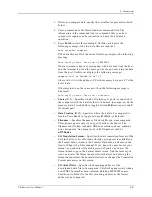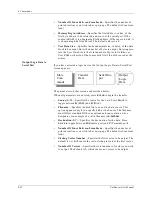
4. Commands
4-90
UniSite-xpi User Manual
•
User Data Size
—The User Data Size specifies how many bytes (in
hex) is read during the Input from Disk operation. The default User
Data Size is 0, which causes all of the data to be input. After the
operation is complete, UniSite-xpi updates the User Data Size
parameter to reflect the number of bytes stored to the destination. If a
value less than the size of data file input is entered, the number of
bytes equal to that value are actually stored. This field appears only if
a non-JEDEC format has been selected.
Output To Disk
The Output To Disk command saves data from a disk file or from RAM to
another disk file. The data in the newly created disk file can be stored in
any of the supported translation formats.
This command is useful if you already have a data file and want to save it
in another translation format. This command is just like the Upload Data
command, except that the formatted data is sent to a disk file rather than
to a port.
Follow the steps below to output data in a translation format and store it
in a disk file.
1.
Make sure there is enough space on the disk in the drive to hold the
file you are writing.
Use the View Directory command on the File Menu to check the
amount of free space on the disk you are going to save the file to.
2.
Specify the settings for the parameters listed below.
3.
Press E
NTER
to initiate this command. UniSite-xpi displays
Data transfer complete
when the file has been output to the disk.
The following parameters appear on the Output To Disk File With
Translation screen:
•
Source
(R,D)—Select the Source for the disk file data. Press S
PACE
to
toggle between R (RAM) and D (disk).
•
Filename
—Specifies the name of the disk file from which the data is
taken. This option appears only if disk is selected as the Source. The
filename parameter must follow standard DOS conventions, and can
contain a drive designator. An example of a valid filename is
b:27256.dat
.
•
Output Filename
—Specifies the name of the disk file you want the
formatted data sent to. The filename must follow standard DOS
conventions, and can contain a drive designator. An example of a
valid filename is a:27256.hex.
Main
Menu
More
Com-
mands
Transfer
Data
Output to
Disk
Summary of Contents for UniSite-xpi
Page 2: ...981 0014 UniSite Programming System User Manual Also Covering Legacy UniSite Programmers ...
Page 72: ...2 Setup and Installation 2 42 UniSite xpi User Manual ...
Page 134: ...3 Getting Started 3 62 UniSite xpi User Manual ...
Page 238: ...5 Computer Remote Control 5 10 UniSite xpi User Manual ...
Page 296: ...6 Translation Formats 6 58 UniSite xpi User Manual ...
Page 402: ...Keep Current Subscription Service 6 Keep Current ...






























